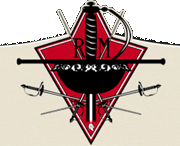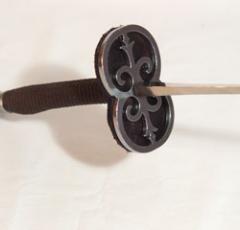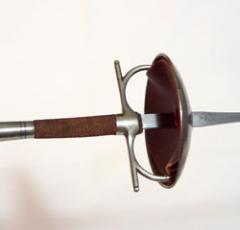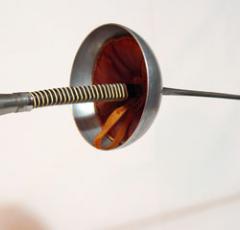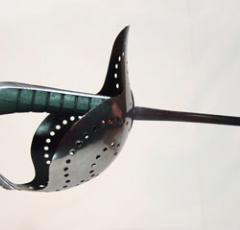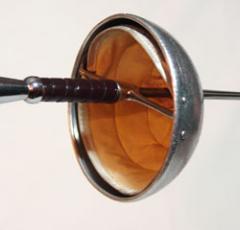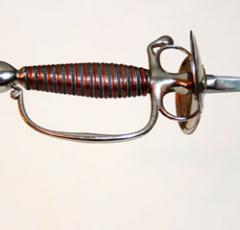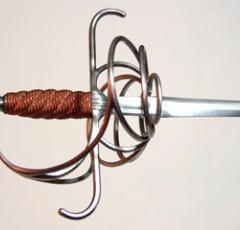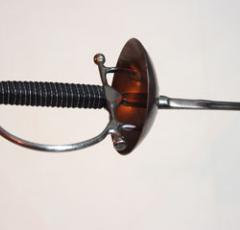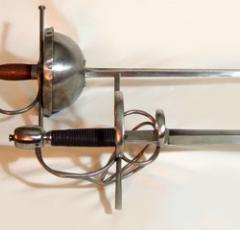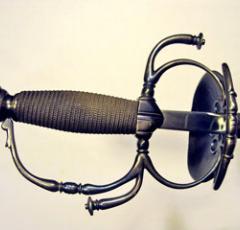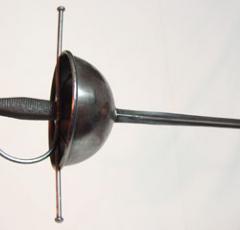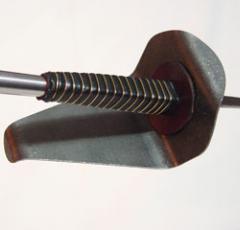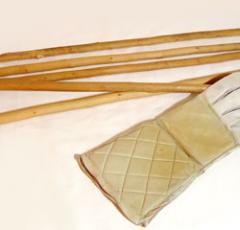Weapons & Schools Core Curriculum
Classical Fencing
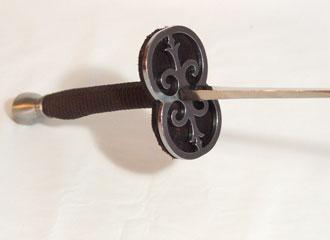
French Foil, close-up of hilt.
The classical French school of foil derives from the theory of small-sword fencing. In its position and movement the French school along with its footwork is subdued, discarding any superfluous movement and expenditure of physical energy. The arm in the guards and parries is not as extended as in the Italian school. All actions are executed with a minimum of force, relying on exact positioning of the body and placement of the blade. All of the fingers rest upon the almost straight grip of the foil, which is manipulated via the use of the fingers aided by a supple wrist.
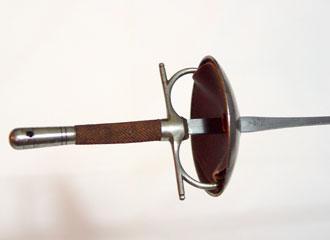
Italian Foil, close-up of hilt.
Rather than a single monolithic Italian school of fencing, there existed many different regional variants during the classical era. These schools may be generally divided into northern and southern. The southern schools tend to be very aggressive in nature, while the northern schools are influenced in part by French theory and practice. The northern schools are more forceful than the French school, but a bit more subdued in their character than the southern schools.
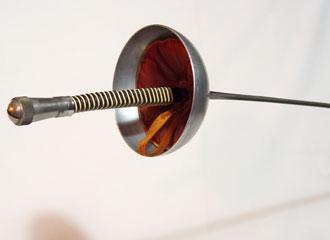
French Dueling Sword, close-up of hilt, showing pad and martingale.
In the last quarter of the 19th century some masters believed that training with the foil had become overly academic, much to the detriment of those called to the dueling ground. A new approach thus developed to rectify this problem. Many aspects of rapier and early small-sword fencing of the 17th century were revived and infused into this new system. The guard position was more upright with the arm and blade held more extended placing the blade in a more horizontal plane.
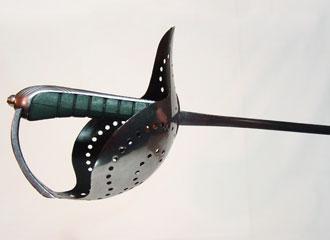
Italian Dueling Sabre, “Pecoraro model”, close-up of hilt.
The Italian school of sabre is based on the dueling sabre, not the military sabre. Its foundation is the study and practice of the molinelli, which are types of circular cuts. There are two schools, which may be generally divided, into northern and southern. The southern school emphasizes the execution of the molinelli, with the wrist as the axis of rotation, while the northern school emphasizes the elbow as its axis. As is typical of the Italian schools, the guard position is relatively low.
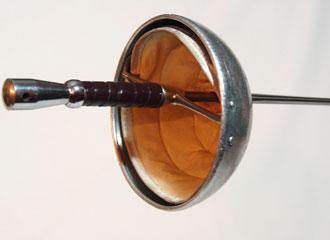
Italian Dueling Sword, close-up of hilt, showing pad and cross bar configuration.
After investigating the French dueling sword system, Maestri Agesilao and Aurelio Greco subsequently developed a uniquely Italian approach to fencing with the dueling sword. Maestri Greco also designed and created a new type of Italian dueling sword with an offset perforation on the cup-hilt fitted with a triangular cross-section blade as the French one but forged with a ricasso as the traditional Italian blade.
The dueling sword (spada) taught is firmly grounded in the system created by Aurelio Greco.
Historical Fencing
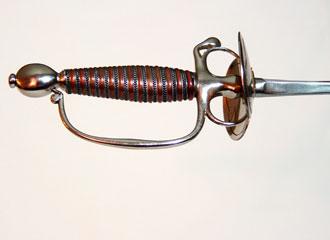
French Small-sword replica, close-up of hilt.
In mid-17th century France, the rapier was greatly reduced in length and weight, leading to the development of the weapon that we know of today as the small-sword. Although having its origins in the Italian school, the French masters were able to develop a school of fencing that took advantage of the greater facility and ease of handling of this new weapon.
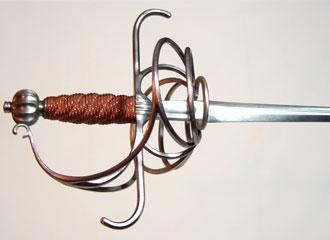
Italian Rapier replica, close-up hilt.
In the 17th century there existed many different regional variants, various postures and guard positions, yet there was still what we can classify as an Italian school. For example, Italian masters were all in agreement that there were four guard positions and four primary hand positions. The Italian school was also consistent in a linear approach to rapier fencing where the adversaries moved along a theoretical straight line in the course of the combat. Nonetheless, variants of sidestepping and evasive body displacements were taught and utilized in this system of armed personal combat.
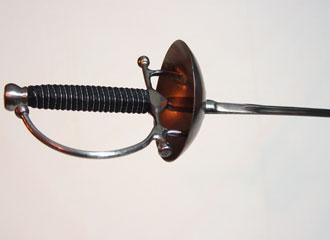
Late Italian Rapier replica, close-up of hilt.
Late Italian rapier is sometimes erroneously thought of as an “Italian small-sword”. The small-sword is properly a French weapon; in contemporary Italy the weapon used was a cup-hilt rapier of reduced size as compared to those used in earlier periods, still termed, simply, the spada. The Italian spada was used well into the nineteenth century. The development of this weapon and the manner of its use reflects an evolution of the systems of the 17th century rapier suited to this particular weapon and its social-cultural environment.
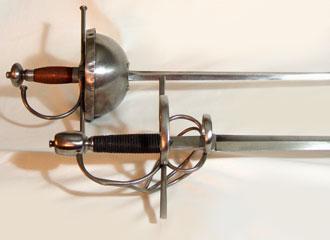
Spanish Rapiers replicas, close-up of Swept-hilt and Cup-hilt.
Don Jeronimo de Carranza founded the system and school of Spanish rapier known as La Verdadera Destreza, in the late 16th century. Unlike other schools that existed during that time there were no guard positions. Rather the Spanish school utilized one single stance/posture. The swordsman assumes an upright, semi-profiled posture with the heels slightly apart. The arm is extended straight forward at shoulder level holding the sword with its blade parallel to the ground menacing the adversary. All combat takes place within an imaginary circle on the ground.
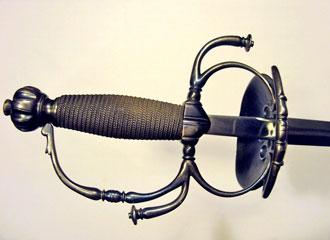
Spanish Small-sword, close-up of hilt.
Firmly rooted in 17th century Spanish rapier fencing (La Verdadera Destreza), this system of small-sword includes features of the French and Italian schools. All of this is systematized into a doctrine that is predominantly Spanish applied to what is in essence a smaller, shorter and lighter rapier. One unique aspect of this system is that unlike French small-sword it includes all of the cutting technique of the earlier 17th century rapier.
The system of Spanish small-sword (espadin) taught is based on the mixed doctrine of Don Manuel Antonio De Brea (1805).
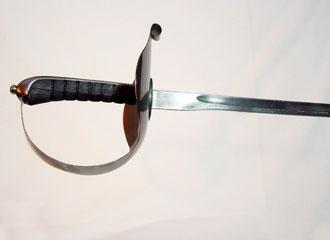
Sabre, “Hutton model”, close-up of hilt.
The Spanish sabre is a military weapon intended to be used as an infantry/artillery sabre. Its techniques, methods and principles are firmly based on the teachings of the early Spanish masters. Utilizing powerful cuts along with thrusts the Spanish sabre found equal use on the battlefield facing other weapons as well as for personal combat on the dueling field.
The system of Spanish sabre taught is based on the teachings of Don Simon De Frias (1809) and Don Jaime Merlo Y Casademunt (1862, 1878).
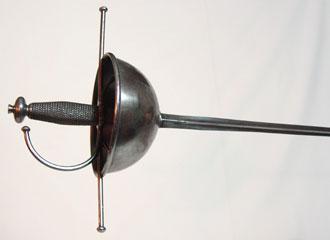
Spanish Cup-hilt rapier replica, close-up of hilt.
Standing firmly on the system of the earlier Spanish masters beginning with Carranza, this system is a mixed doctrine that incorporates certain elements of the Italian and French schools. The system taught is based on the teachings of Don Antonio Heraud y Clavijo De Soria (1892) and Don Antonio Alvarez Garcia (1893).
Late Spanish rapier (single rapier, rapier & dagger, and rapier & cloak).
Traditional Systems
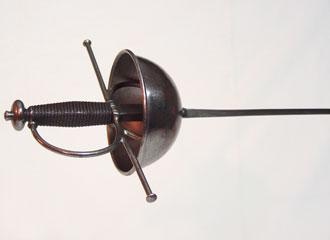
Cup-hilt Rapier replica, close-up of hilt.
Traditional rapier fencing is a school of rapier that has been passed down from master to student within our lineage. It is a mixed doctrine containing elements of the French, Italian and Spanish schools of fencing. The rapier used is a Spanish type cup-hilt rapier that is shorter and lighter than those of the earlier periods. The dagger is also of the Spanish shell-guard type with a somewhat long blade. The emphasis is on sophisticated combinations of blade actions along with both circular and linear footwork.
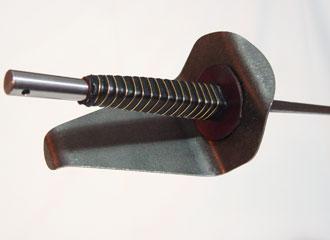
French Dagger (Poignard), close-up of shell-guard hilt.
Dagger fencing is a traditional system that has been passed down from master to student. Firmly grounded in the French school, it is a system that includes thrust and cut technique but places its emphasis on thrusting. It utilizes both linear and circular footwork.There are three methods of gripping the dagger, which are the foil grip, the sabre grip and the reverse grip.
Specialized Training Method
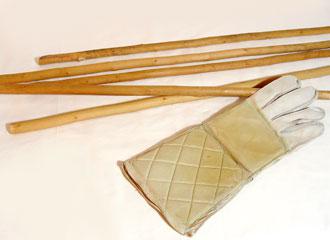
“La Canne”, sticks used for training.
In the 19th century many masters taught beginning students of
sabre by utilizing a stick with or without a guard to protect the hand. The students learned manipulation of the weapon as well as body mechanics, in preparation for the use of the actual weapon. There were also systems of cane for self-defense using the gentleman’s walking stick and toward the end of the 19th and beginning of the 20th century systems of la canne as a combat sport.
